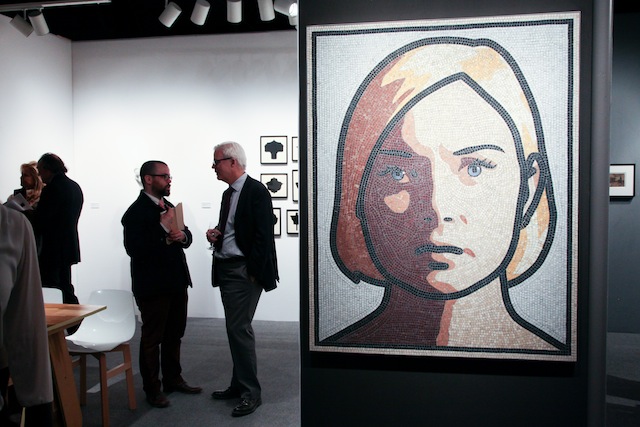
Photo: Paul Porter/BFAnyc.com
The Twelve
Almost two generations ago, in The Painted Word, Tom Wolfe wrote that there are only 5,000 people in the art world. And at that time, there probably were. In recent years, the community has expanded, even exploded. But the core 5,000, those 20th-century originals, seem to have an ersatz reunion of sorts every year in the booths and aisles of the ADAA Art Show.
“Eli!” “Jerry!” “Lucy!” The shouts of welcome were genuine at its Tuesday night opening.
How much has changed? The show began during the rise of the Great Art Boom in 1987, and a look at the ADAA exhibitor list from about 20 years ago is an eye-opener. The art world worships today’s power and assumes its permanence. Let’s call it the “No World before Zwirner” short-term memory syndrome.
In 1995, there were 58 dealers showing at The Art Show, most based, by the way, in SoHo. Only 12 of them still show at the fair. (Though some do exhibit, like Barbara Gladstone, at other New York fairs.) So I wandered the fair Tuesday night and asked these and other survivors how they’ve lasted—and what their advice is for young gallerists.
Nancy Hoffman credits “loyalty” to artists and collectors: They still show some of the same artists they showed in the 1970s, notes Hoffman, but the gallery also added a project space for younger artists about a decade ago.
The advice of Jane Kallir, director of Galerie St. Etienne—now in its 75th year—is to know art history and to know the art market, and where they intersect and don’t, and why. She also advises would-be gallerists to figure out early on whether they “need a boss or need to be the boss,” and design a career accordingly. Several dealers warned that that the job is much more all-consuming and expensive than it used to be, especially given the rise of the art fair circuit. A handful warned wryly about the impact on marriages.
Bottom line: For a gallery to survive long-term, it helps to have good kids interested in the business (Acquavella), good programs (Marian Goodman), a good newsletter (St. Etienne), a lock on your niche (Hirschl & Adler), all of the above, and some luck.
Beverly Hills dealer Marc Selwyn, who exhibits at The Armory Show but has been a visitor to the ADAA one over the years notes, “You have to have a track record. After 10 or 15 years, people need to be saying ‘Yes, [he or she] saw that early.”
And there is something else worth keeping in mind, which is self-serving but honest: Most of the ones who are still around talk, openly or otherwise, to the press.
As for the ADAA galleries no longer with us, they surprisingly departed in the same ways property traditionally comes to the art market: death (the groundbreaking inventor-of-much, André Emmerich), divorce (C&M arts then became L&M, now thriving as Mnuchin; Pace, too, has split with Wildenstein), and debt (Berry-Hill), not to mention legal bills (Knoedler, Salander-O’Reilly). But their businesses are no less historically important for being closed or reformed—or disgraced.
In other fields, like film studies, students are required to learn a business canon as much as an aesthetic one. They know who begat whom, and they are supposed to know. The film student has to learn what Sam Goldwyn did, but does the art student have to learn what Holly Solomon did? Not so much.
That said, the reason to pay attention to the ADAA fair is not nostalgia. This year’s fair has gorgeous works by Laurie Simmons, Ellsworth Kelly, and Charles LeDray, among several other highlights. It’s open till Sunday, March 9—and, by the way, David Zwirner’s showing too.
Pilgrim’s Progress to the Met
How do you ship 800-year-old stained glass panels? Reluctantly. The Metropolitan Museum of Art’s Cloisters is hosting, though May 18, an exhibition of six medieval windows from Canterbury Cathedral. It was the “very first time in over 800 years” that they had been moved, notes the dean of the cathedral, the Very Reverend Robert Willis, and to some at the Cathedral, it was like “sending your babies abroad.” For the “Radiant Light” exhibition, the windows were separated into dozens of panels for shipping in custom-designed vertical crates within crates. The windows were also placed on separate flights—just in case. But that wasn’t all the protection the art loan received. Explains Reverend Willis, “When they were done packing, they called me and said, ‘We think it’s safe—but can you come bless it?’”
Curator Cavalcade
When the Indianapolis Museum hired a new curator of contemporary art last week—the well-regarded Tricia Paik, formerly of The Modern and the St. Louis Art Museum—the city’s newspaper The Indianapolis Star, put it on the front page. . . . The Dallas Art Week, April 4–14, names a curator of music, and even better, picks Richard Phillips for the post. As Jerry Hall is guest of honor, do we expect “Paint It Black”? . . . Art21 holds an art and culture trivia contest, “Are You Smarter than a Curator?” March 20 at the Met Museum.
Follow Alexandra Peers on Twitter@LoisLaneNY.